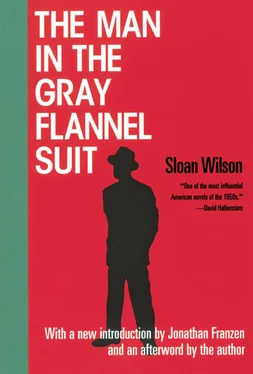The latter half of the book belongs to Betsy — Tom’s better half. Although their relationship has consisted of three years of puppy love followed by four and a half years of wartime lies and separation, followed by another nine years of making love “without passion” and raising a family “without any real emotion except worry,” Betsy stands by her man. She launches a program of family self-improvement. She gets Tom involved in local politics. She sells the hated house and leads the family out of its dull exile and into more exclusive precincts. She volunteers for a life of full-time high-risk entrepreneurship. Most important, Betsy ceaselessly exhorts Tom to be honest. The story line, in consequence, gradually drifts away from “Appealingly Flawed Couple Wrestles With Fifties Conformity” toward “Guilt-Ridden Man Passively Receives Aid From Excellent Woman.” Although people as excellent as Betsy Rath exist in the world, they don’t make excellent characters. In a preface to the novel, Sloan Wilson offers such effusive an acknowledgement of his own better half, his first wife Elise (“Many of the thoughts on which this book is based are hers”), that you may begin to wonder whether the novel is not a kind of love letter from Wilson to Elise, a celebration of his marriage to her, maybe even an attempt to dispel his own doubts about his marriage, to talk himself into love. Certainly something dubious goes down in the distaff half of the book. Certainly, despite the many conflicts chez Rath, Wilson never lets his characters come near the possibility of true unhappiness.
One of the clear implications of The Man in the Gray Flannel Suit is that the harmony of society depends on the harmony of each household. The war has sickened the United States by driving a wedge between men and women; the war has sent millions of men overseas to murder and witness death and have sex with local girls while millions of American wives and fiancées waited cheerfully at home, nursed their faith in storybook endings, and shouldered the burden of being ignorant; and now only honesty and openness can repair the bond between men and women and heal an ailing society. As Tom concludes: “I may not be able to do anything about the world, but I can set my life in order.”
If you believe in love and loyalty and truth and justice, you may finish reading The Man in the Gray Flannel Suit , as I did, with tears in your eyes. But even as your heart is melting, you may feel annoyed with yourself for succumbing. Like Frank Capra in his goopier films, Wilson asks you to believe that if a man will only show true courage and honesty, he’ll be offered a perfect job within walking distance of his home, the local real-estate developer won’t cheat him, the local judge will dispense perfect justice, the inconvenient villain will be sent packing, the captain of industry will reveal his decency and civic spirit, the local electorate will vote to tax itself more heavily for the sake of schoolchildren, the former lover overseas will know her place and not make any trouble, and the martini-drenched marriage will be saved.
Whether you buy this or not, the novel does succeed in capturing the spirit of the fifties — the uneasy conformity, the flight from conflict, the political quietism, the cult of the nuclear family, the embrace of class privileges. The Raths are a lot more gray-flannel than they ever seem to realize. What distinguishes them from their “dull” neighbors is finally not their sorrows or their eccentricities but their virtues. The Raths toy with irony and resistance in the book’s early pages, but by the last pages they’re happily getting rich. The smiling Tom Rath of chapter 41 would be an image of complacency, an object of fear and contempt, for the confused Tom Rath of chapter 1. Meanwhile Betsy Rath emphatically rejects the notion that the malaise of the suburbs might have systemic causes. (“People rely too much on explanations these days,” she thinks, “and not enough on courage and action.”) Tom is confused and unhappy not because war creates moral anarchy or because his employer’s business consists of “soap operas, commercials, and yammering studio audiences.” Tom’s problems are purely personal, just as Betsy’s activism is strictly local and domestic. The deeper existential questions that are stirred up by four years of war (or by four weeks in the offices of United Broadcasting, or by four days of motherhood on a dull street in Westport) are abandoned: an unavoidable casualty, perhaps, of the decade itself.
The Man in the Gray Flannel Suit is a book about the fifties. The first half can still be read for fun, the second half for a glimpse of the coming sixties. It was the fifties, after all, that gave the sixties their idealism — and their rage.
Jonathan Franzen
July 2002
1
BY THE TIME they had lived seven years in the little house on Greentree Avenue in Westport, Connecticut, they both detested it. There were many reasons, none of them logical, but all of them compelling. For one thing, the house had a kind of evil genius for displaying proof of their weaknesses and wiping out all traces of their strengths. The ragged lawn and weed-filled garden proclaimed to passers-by and the neighbors that Thomas R. Rath and his family disliked “working around the place” and couldn’t afford to pay someone else to do it. The interior of the house was even more vengeful. In the living room there was a big dent in the plaster near the floor, with a huge crack curving up from it in the shape of a question mark. That wall was damaged in the fall of 1952, when, after struggling for months to pay up the back bills, Tom came home one night to find that Betsy had bought a cut-glass vase for forty dollars. Such an extravagant gesture was utterly unlike her, at least since the war. Betsy was a conscientious household manager, and usually when she did something Tom didn’t like, they talked the matter over with careful reasonableness. But on that particular night, Tom was tired and worried because he himself had just spent seventy dollars on a new suit he felt he needed to dress properly for his business, and at the climax of a heated argument, he picked up the vase and heaved it against the wall. The heavy glass shattered, the plaster cracked, and two of the laths behind it broke. The next morning, Tom and Betsy worked together on their knees to patch the plaster, and they repainted the whole wall, but when the paint dried, the big dent near the floor with the crack curving up from it almost to the ceiling in the shape of a question mark was still clearly visible. The fact that the crack was in the shape of a question mark did not seem symbolic to Tom and Betsy, nor even amusing — it was just annoying. Its peculiar shape caused people to stare at it abstractedly, and once at a cocktail party one of the guests who had had a little too much to drink said, “Say, that’s funny. Did you ever notice that big question mark on your wall?”
“It’s only a crack,” Tom replied.
“But why should it be in the form of a question mark?”
“It’s just coincidence.”
“That’s funny,” the guest said.
Tom and Betsy assured each other that someday they would have the whole wall replastered, but they never did. The crack remained as a perpetual reminder of Betsy’s moment of extravagance, Tom’s moment of violence, and their inability either to fix walls properly or to pay to have them fixed. It seemed ironic to Tom that the house should preserve a souvenir of such things, while allowing evenings of pleasure and kindness to slip by without a trace.
The crack in the living room was not the only reminder of the worst. An ink stain with hand marks on the wallpaper in Janey’s room commemorated one of the few times Janey ever willfully destroyed property, and the only time Betsy ever lost her temper with her and struck her. Janey was five, and the middle one of the three Rath children. She did everything hard: she screamed when she cried, and when she was happy her small face seemed to hold for an instant all the joy in the world. Upon deciding that she wanted to play with ink, she carefully poured ink over both her hands and made neat imprints on the wallpaper, from the floor to as high as she could reach. Betsy was so angry that she slapped both her hands, and Janey, feeling she had simply been interrupted in the midst of an artistic endeavor, lay on the bed for an hour sobbing and rubbing her hands in her eyes until her whole face was covered with ink. Feeling like a murderess, Betsy tried to comfort her, but even holding and rocking her didn’t seem to help, and Betsy was shocked to find that the child was shuddering. When Tom came home that night he found mother and daughter asleep on the bed together, tightly locked in each other’s arms. Both their faces were covered with ink. All this the wall remembered and recorded.
Читать дальше











